| Ambivalent Empire Reading with Questions |
|---|
| www.studenthandouts.com ↣ American History ↣ American History Readings |
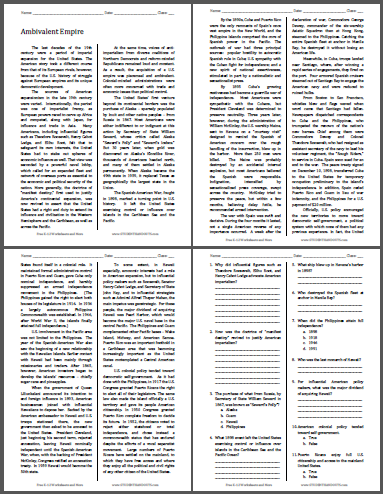 The last decades of the 19th century were a period of imperial expansion for the United States. The American story took a different course from that of its European rivals, however, because of the U.S. history of struggle against European empires and its unique democratic development.
The last decades of the 19th century were a period of imperial expansion for the United States. The American story took a different course from that of its European rivals, however, because of the U.S. history of struggle against European empires and its unique democratic development.The sources of American expansionism in the late 19th century were varied. Internationally, the period was one of imperialist frenzy, as European powers raced to carve up Africa and competed, along with Japan, for influence and trade in Asia. Many Americans, including influential figures such as Theodore Roosevelt, Henry Cabot Lodge, and Elihu Root, felt that to safeguard its own interests, the United States had to stake out spheres of economic influence as well. That view was seconded by a powerful naval lobby, which called for an expanded fleet and network of overseas ports as essential to the economic and political security of the nation. More generally, the doctrine of "manifest destiny," first used to justify America's continental expansion, was now revived to assert that the United States had a right and duty to extend its influence and civilization in the Western Hemisphere and the Caribbean, as well as across the Pacific. At the same time, voices of anti-imperialism from diverse coalitions of Northern Democrats and reform-minded Republicans remained loud and constant. As a result, the acquisition of a U.S. empire was piecemeal and ambivalent. Colonial-minded administrations were often more concerned with trade and economic issues than political control. The United States' first venture beyond its continental borders was the purchase of Alaska – sparsely populated by Inuit and other native peoples – from Russia in 1867. Most Americans were either indifferent to or indignant at this action by Secretary of State William Seward, whose critics called Alaska "Seward's Folly" and "Seward's Icebox." But 30 years later, when gold was discovered on Alaska's Klondike River, thousands of Americans headed north, and many of them settled in Alaska permanently. When Alaska became the 49th state in 1959, it replaced Texas as geographically the largest state in the Union. The Spanish-American War, fought in 1898, marked a turning point in U.S. history. It left the United States exercising control or influence over islands in the Caribbean Sea and the Pacific. By the 1890s, Cuba and Puerto Rico were the only remnants of Spain's once vast empire in the New World, and the Philippine Islands comprised the core of Spanish power in the Pacific. The outbreak of war had three principal sources: popular hostility to autocratic Spanish rule in Cuba; U.S. sympathy with the Cuban fight for independence; and a new spirit of national assertiveness, stimulated in part by a nationalistic and sensationalist press. By 1895 Cuba's growing restiveness had become a guerrilla war of independence. Most Americans were sympathetic with the Cubans, but President Cleveland was determined to preserve neutrality. Three years later, however, during the administration of William McKinley, the U.S. warship Maine , sent to Havana on a "courtesy visit" designed to remind the Spanish of American concern over the rough handling of the insurrection, blew up in the harbor. More than 250 men were killed. The Maine was probably destroyed by an accidental internal explosion, but most Americans believed the Spanish were responsible. Indignation, intensified by sensationalized press coverage, swept across the country. McKinley tried to preserve the peace, but within a few months, believing delay futile, he recommended armed intervention. The war with Spain was swift and decisive. During the four months it lasted, not a single American reverse of any importance occurred. A week after the declaration of war, commodore George Dewey, commander of the six-warship Asiatic Squadron then at Hong Kong, steamed to the Philippines. Catching the entire Spanish fleet at anchor in Manila Bay, he destroyed it without losing an American life. Meanwhile, in Cuba, troops landed near Santiago, where, after winning a rapid series of engagements, they fired on the port. Four armored Spanish cruisers steamed out of Santiago Bay to engage the American navy and were reduced to ruined hulks. From Boston to San Francisco, whistles blew and flags waved when word came that Santiago had fallen. Newspapers dispatched correspondents to Cuba and the Philippines, who trumpeted the renown of the nation's new heroes. Chief among them were commodore Dewey and Colonel Theodore Roosevelt, who had resigned as assistant secretary of the navy to lead his volunteer regiment, the "Rough Riders," to service in Cuba. Spain soon sued for an end to the war. The peace treaty signed on December 10, 1898, transferred Cuba to the United States for temporary occupation preliminary to the island's independence. In addition, Spain ceded Puerto Rico and Guam in lieu of war indemnity, and the Philippines for a U.S. payment of $20 million. Officially, U.S. policy encouraged the new territories to move toward democratic self-government, a political system with which none of them had any previous experience. In fact, the United States found itself in a colonial role. It maintained formal administrative control in Puerto Rico and Guam, gave Cuba only nominal independence, and harshly suppressed an armed independence movement in the Philippines. (The Philippines gained the right to elect both houses of its legislature in 1916. In 1936 a largely autonomous Philippine commonwealth was established. In 1946, after World War II, the islands finally attained full independence.) U.S. involvement in the Pacific area was not limited to the Philippines. The year of the Spanish-American War also saw the beginning of a new relationship with the Hawaiian Islands. Earlier contact with Hawaii had been mainly through missionaries and traders. After 1865, however, American investors began to develop the islands' resources – chiefly sugar cane and pineapples. When the government of Queen Liliuokalani announced its intention to end foreign influence in 1893, American businessmen joined with influential Hawaiians to depose her. Backed by the American ambassador to Hawaii and U.S. troops stationed there, the new government then asked to be annexed to the United States. President Cleveland, just beginning his second term, rejected annexation, leaving Hawaii nominally independent until the Spanish-American War, when, with the backing of President McKinley, Congress ratified an annexation treaty. In 1959 Hawaii would become the 50th state. To some extent, in Hawaii especially, economic interests had a role in American expansion, but to influential policy makers such as Roosevelt, Senator Henry Cabot Lodge, and Secretary of State John Hay, and to influential strategists such as Admiral Alfred Thayer Mahan, the main impetus was geostrategic. For these people, the major dividend of acquiring Hawaii was Pearl Harbor, which would become the major U.S. naval base in the central Pacific. The Philippines and Guam complemented other Pacific bases – Wake Island, Midway, and American Samoa. Puerto Rico was an important foothold in a Caribbean area that was becoming increasingly important as the United States contemplated a Central American canal. U.S. colonial policy tended toward democratic self-government. As it had done with the Philippines, in 1917 the U.S. Congress granted Puerto Ricans the right to elect all of their legislators. The same law also made the island officially a U.S. territory and gave its people American citizenship. In 1950 Congress granted Puerto Rico complete freedom to decide its future. In 1952, the citizens voted to reject either statehood or total independence, and chose instead a commonwealth status that has endured despite the efforts of a vocal separatist movement. Large numbers of Puerto Ricans have settled on the mainland, to which they have free access and where they enjoy all the political and civil rights of any other citizen of the United States. Click here to print. Answer Key: (1) They felt that to safeguard its own interests, the U.S. had to stake out spheres of economic influence as well; (2) Used to assert that the U.S. had a right and duty to extend its influence and civilization around the globe; (3) A - Alaska; (4) Spanish-American War; (5) U.S.S. Maine; (6) commodore George Dewey; (7) C - 1946; (8) Queen Liliuokalani; (9) Geostrategic; Pearl Harbor, which would become the major U.S. naval base in the central Pacific; (10) A - True; (11) A - True. |
 | 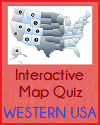 | 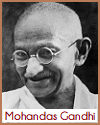 | 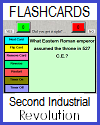 |  | 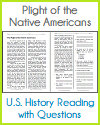 |








